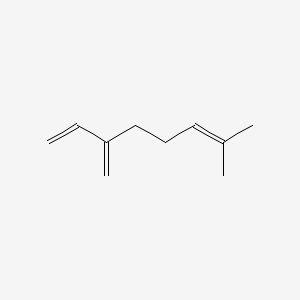| Authors | Title | Published | Journal | PubMed Link |
|---|---|---|---|---|
| Röscheisen C et al. | Influence of beta-myrcene on sister-chromatid exchanges induced by mutagens in V79 and HTC cells. | 1991 | Mutat. Res. | pmid:1908947 |
| Qiao Y et al. | Characterization of aroma active compounds in fruit juice and peel oil of Jinchen sweet orange fruit (Citrus sinensis (L.) Osbeck) by GC-MS and GC-O. | 2008 | Molecules | pmid:18596659 |
| Palacios SM et al. | Efficacy of essential oils from edible plants as insecticides against the house fly, Musca domestica L. | 2009 | Molecules | pmid:19471213 |
| Kim E and Park IK | Fumigant antifungal activity of Myrtaceae essential oils and constituents from Leptospermum petersonii against three Aspergillus species. | 2012 | Molecules | pmid:22945026 |
| Barbosa LC et al. | Evaluation of the chemical composition of Brazilian commercial Cymbopogon citratus (D.C.) stapf samples. | 2008 | Molecules | pmid:18794790 |
| Oh SY | An Effective Quality Control of Pharmacologically Active Volatiles of Houttuynia cordata Thunb by Fast Gas Chromatography-Surface Acoustic Wave Sensor. | 2015 | Molecules | pmid:26046325 |
| Wang P et al. | Chemical composition and antimicrobial activity of the essential oil from Ambrosia trifida L. | 2006 | Molecules | pmid:17971726 |
| Fähnrich A et al. | Product variability of the 'cineole cassette' monoterpene synthases of related Nicotiana species. | 2011 | Mol Plant | pmid:21527560 |
| Raal A et al. | Content and composition of the essential oil of Thymus serpyllum L. growing wild in Estonia. | 2004 | Medicina (Kaunas) | pmid:15300002 |
| Obelevicius K and Venskutonis R | [The crop-producing power and chemical composition of the essential oil of the cones of hop cultivars]. | 2004 | Medicina (Kaunas) | pmid:15299998 |
| Payo DA et al. | Variability of non-polar secondary metabolites in the red alga Portieria. | 2011 | Mar Drugs | pmid:22163195 |
| De-Oliveira AC et al. | Up- and down-modulation of liver cytochrome P450 activities and associated events in two murine malaria models. | 2010 | Malar. J. | pmid:20307316 |
| Quartu M et al. | Effect of acute administration of Pistacia lentiscus L. essential oil on rat cerebral cortex following transient bilateral common carotid artery occlusion. | 2012 | Lipids Health Dis | pmid:22239952 |
| Rao VS et al. | Effect of myrcene on nociception in mice. | 1990 | J. Pharm. Pharmacol. | pmid:1983154 |
| Kong JO et al. | Nematicidal and Propagation Activities of Thyme Red and White Oil Compounds toward Bursaphelenchus xylophilus (Nematoda: Parasitaphelenchidae). | 2007 | J. Nematol. | pmid:19259493 |
| Utrilla MP et al. | Santolindiacetylene, a polyacetylene derivative isolated from the essential oil of Santolina canescens. | 1995 | J. Nat. Prod. | pmid:8594153 |
| Perrucci S et al. | Structure/activity relationship of some natural monoterpenes as acaricides against Psoroptes cuniculi. | 1995 | J. Nat. Prod. | pmid:7595592 |
| Baik JS et al. | Chemical composition and biological activities of essential oils extracted from Korean endemic citrus species. | 2008 | J. Microbiol. Biotechnol. | pmid:18239420 |
| Lee JH and Hong SK | Comparative analysis of chemical compositions and antimicrobial activities of essential oils from Abies holophylla and Abies koreana activities of essential oils from Abies holophylla and Abies koreana. | 2009 | J. Microbiol. Biotechnol. | pmid:19420993 |
| Lee JH et al. | Chemical composition and antimicrobial activity of essential oil from cones of Pinus koraiensis. | 2008 | J. Microbiol. Biotechnol. | pmid:18388468 |
Myrcene
Myrcene is a lipid of Prenol Lipids (PR) class. Myrcene is associated with abnormalities such as Hypomenorrhea, abnormal fragmented structure, Nephrosis, Renal tubular disorder and Kidney Diseases. The involved functions are known as Anabolism, Gene Expression, Protein Biosynthesis, Mutation and Selection, Genetic. Myrcene often locates in Plastids, Proboscis, Body tissue, Clone and soluble. The associated genes with Myrcene are TTPA gene, monoterpene synthase, Genome, 4S-limonene synthase and Homologous Gene. The related lipids are Pinene, Octanols, Membrane Lipids and Fatty Acids, Unsaturated.
Cross Reference
Introduction
To understand associated biological information of Myrcene, we collected biological information of abnormalities, associated pathways, cellular/molecular locations, biological functions, related genes/proteins, lipids and common seen animal/experimental models with organized paragraphs from literatures.
What diseases are associated with Myrcene?
Myrcene is suspected in Nephrosis, Kidney Diseases, Dehydration, Hypomenorrhea, Renal tubular disorder and other diseases in descending order of the highest number of associated sentences.
Related references are mostly published in these journals:
| Disease | Cross reference | Weighted score | Related literature |
|---|
No disease MeSH terms mapped to the current reference collection.
PubChem Associated disorders and diseases
What pathways are associated with Myrcene
There are no associated biomedical information in the current reference collection.
PubChem Biomolecular Interactions and Pathways
Link to PubChem Biomolecular Interactions and PathwaysWhat cellular locations are associated with Myrcene?
Visualization in cellular structure
Associated locations are in red color. Not associated locations are in black.
Related references are published most in these journals:
| Location | Cross reference | Weighted score | Related literatures |
|---|
What functions are associated with Myrcene?
Related references are published most in these journals:
| Function | Cross reference | Weighted score | Related literatures |
|---|
What lipids are associated with Myrcene?
Related references are published most in these journals:
| Lipid concept | Cross reference | Weighted score | Related literatures |
|---|
What genes are associated with Myrcene?
Related references are published most in these journals:
| Gene | Cross reference | Weighted score | Related literatures |
|---|
What common seen animal models are associated with Myrcene?
There are no associated biomedical information in the current reference collection.
